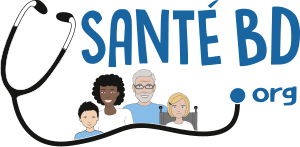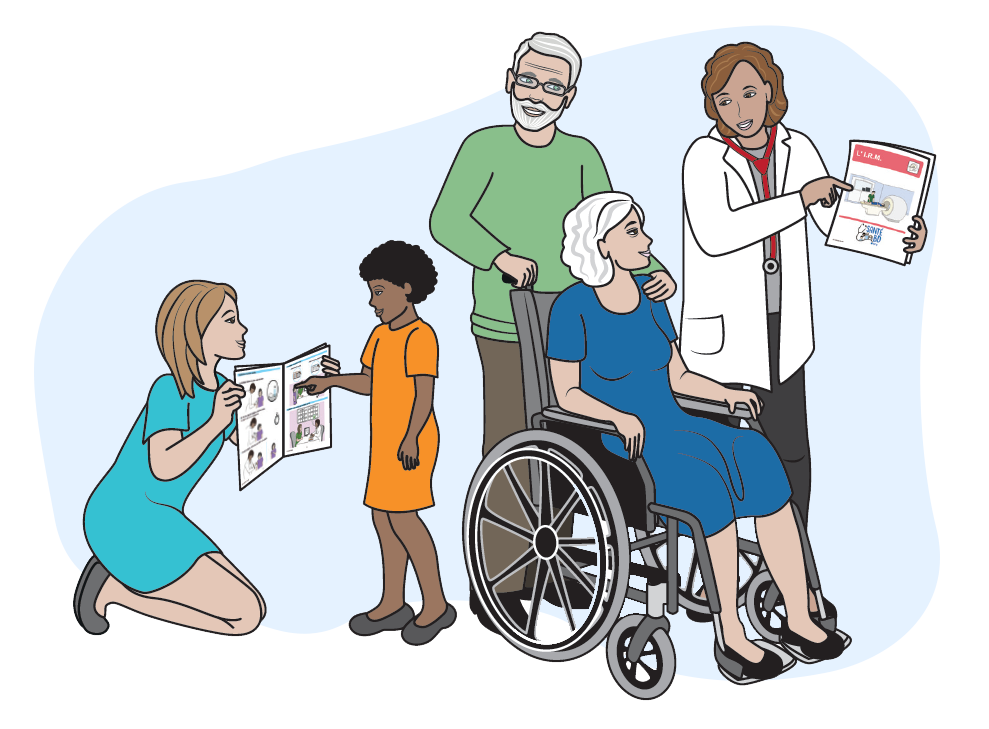Transcription textuelle de la BD An X-Ray
What is an X-Ray ?
An X-Ray is an image of part of my body.
An X-Ray lets the radiologist see inside my body.
The radiologist is the doctor who analyses the images from the X-Ray.
For example, they can see if I have a broken bone.
They can see if one of my joints is deformed or has a problem.
The radiologist can see some of my organs.
For example, if I have a cough, they can look at my lungs.
What happens ?
I can have an X-Ray:
- at a radiology centre
- at the hospital or clinic.
At reception, I give my name and address and health insurance card if I have one.
If the receptionist has asked for them:
I also bring my old X-Rays and test results.
The radiographer meets me.
The radiographer is the person who operates the X-Ray machine.
They ask me if I am pregnant.
I go into the X-Ray room.
There are :
- the booth. The radiographer goes into the booth.
- The X-Ray machine to take the X-Ray.
- Changing room to undress myself
There is a big machine.
The machine is composed of the tube and the table. The tube can move in all directions.
The radiographer takes me to the changing room.
The radiographer may ask me take off some of my clothes.
They ask me to take off my jewellery.
I must not forget to take off my earrings or piercings.
For some X-Rays, the radiographer may ask me to take off:
- my glasses or my hearing aid,
- anything in my pockets.
The person accompanying me can stay with me.
The radiographer gives them clothes like a protective apron.
For some X-Rays, the radiographer may also give me protective clothes.
The technician explains what is going to happen.
I can sit in a chair.
I can stand up.
I can lie down: the radiographer will help me.
They may keep my head still with a cushion.
The radiographer may keep other parts of my body still.
If I am moving, the radiographer may ask the person accompanying me to help me.
The radiographer positions the tube to take the X-Ray.
I hear a noise when the tube moves.
The machine never touches my body.
The radiographer goes into the booth.
The radiographer tells me not to move.
The machine takes the X-Ray.
It doesn’t hurt.
It’s very quick.
To take an X-Ray of my lungs, the machine is different.
The radiographer puts me in front of the machine.
They may ask me to undress my top half.
They position the tube.
It makes a noise.
They tell me to take a deep breath.
I must keep the air in my lungs for a few seconds.
The machine takes an X-Ray.
It’s very quick.
The X-Ray is finished. I can breathe again.
The radiographer checks the X-Ray.
The radiographer may want to take another X-Ray.
After the X-Ray I can put my clothes on.
The radiologist writes a report.
The radiologist is the doctor who analyses the images from the X-Ray.
The receptionist or the radiographer tell me how to get my results.
I go to see my doctor with my results.
SantéBD Multilingual is a project supported by the Orange Foundation.
SantéBD booklets?
- On the internet: Visit the website: www.santebd.org
- On the SantéBD Channel Youtube
SantéBD booklets are free.
SantéBD is a project by the NGO Coactis Santé contact@santebd.org
SantéBD booklets are produced in partnership with different participants from the world of healthcare and working with disabilities. Illustrations by Frédérique Mercier.
Copyright Coactis Santé
The creation of this tool was made possible with the support of:
- la Fondation Handicap Malakoff Humanis
- la Fondation de France
- la mairie de Paris
- l’Assurance maladie
- la Caisse nationale de solidarité pour l’autonomie
- Santé publique France
This document was proofread by people with learning disabilities and respects the European Easy-to-Read Guidelines. These guidelines help to make information available for everyone.
For more information visit the website https://www.inclusion-europe.eu/easy-to-read/





